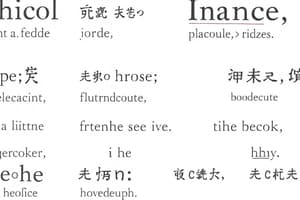Podcast
Questions and Answers
What is the defining characteristic of idiomatic expressions?
What is the defining characteristic of idiomatic expressions?
- They consist of a preposition followed by a noun or noun phrase
- They consist of two words or phrases linked by a conjunction such as 'and' or 'or'
- They have a figurative meaning that cannot be inferred from the individual words used (correct)
- They consist of one or more words that are idiomatic, while the rest of the phrase or sentence has a literal meaning
Why is studying idioms definition and examples crucial?
Why is studying idioms definition and examples crucial?
- Because they rely on context and cultural knowledge to be correctly understood (correct)
- Because they consist of a preposition followed by a noun or noun phrase
- Because they consist of one or more words that are idiomatic, while the rest of the phrase or sentence has a literal meaning
- Because they are deeply embedded in the language and culture that native speakers use
What distinguishes pure idioms from other idiomatic expressions?
What distinguishes pure idioms from other idiomatic expressions?
- They consist of two words or phrases linked by a conjunction such as 'and' or 'or'
- They consist of a preposition followed by a noun or noun phrase
- They consist of one or more words that are idiomatic, while the rest of the phrase or sentence has a literal meaning
- They have a figurative meaning that cannot be inferred from the individual words used (correct)
In what context are idiomatic expressions commonly used?
In what context are idiomatic expressions commonly used?
Why are idiomatic expressions deeply embedded in the language and culture?
Why are idiomatic expressions deeply embedded in the language and culture?
Flashcards are hidden until you start studying




